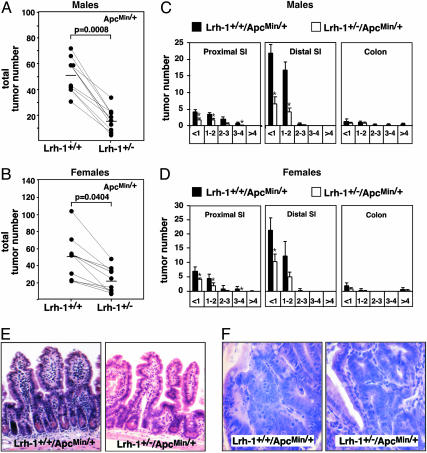Fig. 1.
Haploinsufficiency of LRH-1 reduces tumor multiplicity in ApcMin/+ mice. (A and B) Total tumor number in the gastrointestinal tract of 18-week-old male (A) and female (B) single C57BL/6J-Lrh-1+/+/ApcMin/+ and double C57BL/6J-Lrh-1+/–/ApcMin/+ heterozygous mutant littermates (n = 10 per genotype and per gender). Processing and analysis of the gastrointestinal tract is described in Experimental Procedures. Animals were studied on a pure C57BL/6J background and on a standard chow diet. Single and double heterozygous mutant littermates are represented by lines. The mean tumor number is indicated by a bar. Mann–Whitney U test was used to compare data from different genotypes. Differences were considered statistically significant at P < 0.05. (C and D) Tumor distribution by number and diameter in proximal small intestine (SI), distal small intestine, and colon of male (C) and female (D) single C57BL/6J-Lrh-1+/+/ApcMin/+ and double heterozygous C57BL/6J-Lrh-1+/–/ApcMin/+ mutant mice. x axis represents tumor diameter (in mm). *, Statistically significant at P < 0.05 (ANOVA). (E and F) Representative hematoxylin/eosin staining of normal (E) and adenomatous (F) ileum of single heterozygous C57BL/6J-Lrh-1+/+/ApcMin/+ and double heterozygous C57BL/6J-Lrh-1+/–/ApcMin/+ mice.

